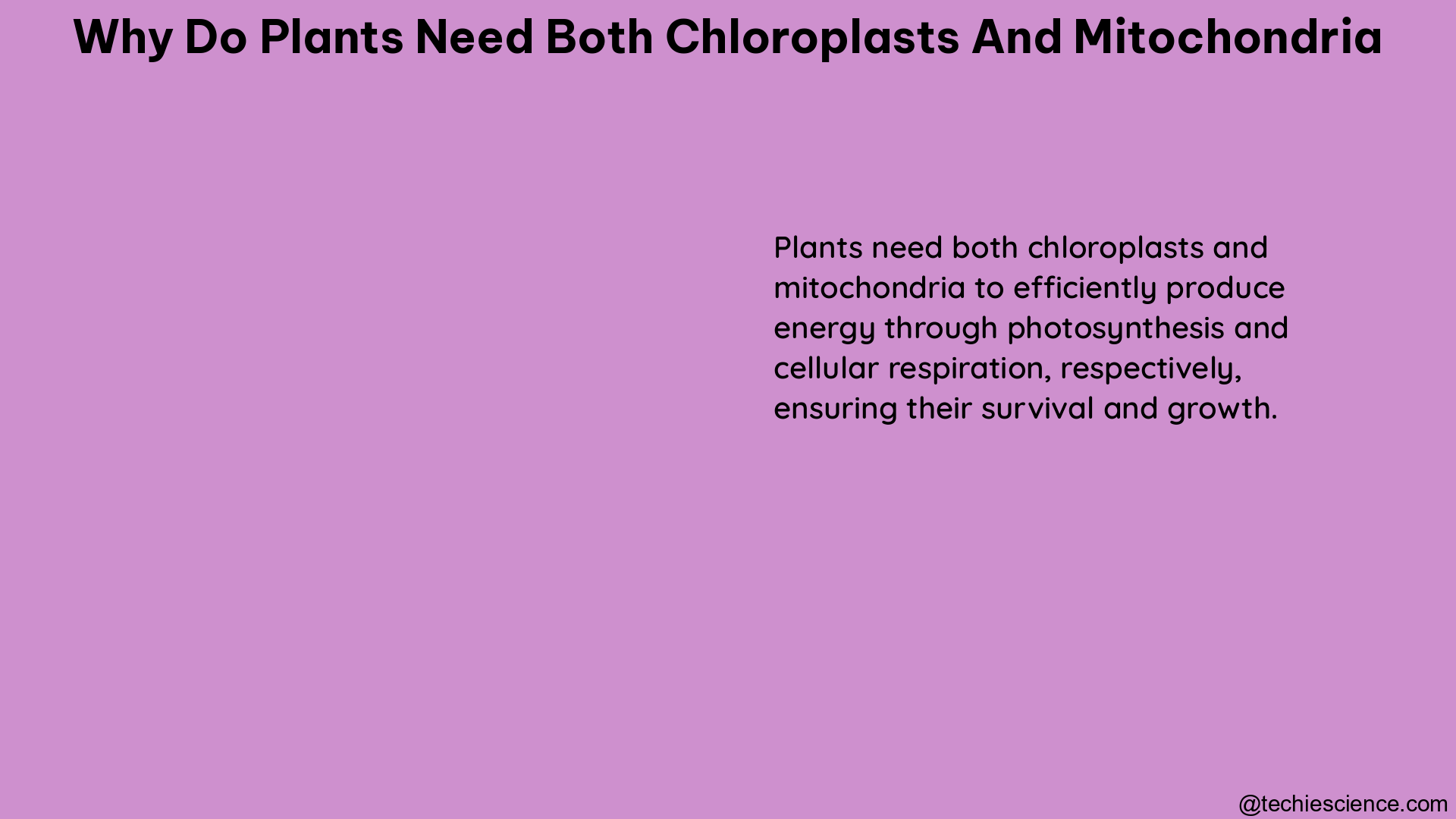Plants require both chloroplasts and mitochondria for their survival and growth due to their unique and essential functions in energy production and metabolism. Chloroplasts are the site of photosynthesis, where light energy is converted into chemical energy in the form of glucose, while mitochondria are the site of cellular respiration, where glucose is broken down to release energy in the form of ATP.
The Role of Chloroplasts in Photosynthesis
Chloroplasts are the specialized organelles found in the cells of plants and some other photosynthetic organisms. They are responsible for the process of photosynthesis, which is the conversion of light energy from the sun into chemical energy in the form of glucose.
During photosynthesis, chloroplasts use carbon dioxide (CO2) and water (H2O) as raw materials, and with the help of sunlight, they produce glucose (C6H12O6) and oxygen (O2). This process can be summarized by the following chemical equation:
6CO2 + 6H2O + Sunlight energy → C6H12O6 + 6O2
The chloroplasts contain a green pigment called chlorophyll, which is responsible for absorbing the light energy from the sun. The light energy is then used to drive a series of chemical reactions that ultimately result in the production of glucose.
The chloroplasts are divided into several compartments, including the outer membrane, inner membrane, and the stroma. The stroma is the fluid-filled space within the chloroplast, and it is where the Calvin cycle, the second stage of photosynthesis, takes place. The Calvin cycle uses the energy and reducing power generated in the first stage of photosynthesis (the light-dependent reactions) to convert carbon dioxide into organic compounds, such as glucose.
The Role of Mitochondria in Cellular Respiration

Mitochondria are the powerhouses of the cell, responsible for the production of the majority of the cell’s energy in the form of adenosine triphosphate (ATP) through the process of cellular respiration.
During cellular respiration, mitochondria break down glucose (C6H12O6) and other organic molecules, such as fats and proteins, to release the energy stored in their chemical bonds. This process involves a series of reactions that ultimately result in the production of ATP, which is the primary energy currency of the cell.
The process of cellular respiration can be summarized by the following chemical equation:
C6H12O6 + 6O2 → 6CO2 + 6H2O + 36-38 ATP
Mitochondria are composed of an outer membrane and an inner membrane, which is highly folded to increase the surface area for the various enzymes and protein complexes involved in the process of cellular respiration. The inner membrane is the site of the electron transport chain, where the majority of ATP is produced through the process of oxidative phosphorylation.
The Interdependence of Chloroplasts and Mitochondria
Chloroplasts and mitochondria share a common evolutionary origin, with chloroplasts believed to have originated from cyanobacteria and mitochondria from proteobacteria. Both organelles contain their own DNA and are capable of self-replication, although they rely on the host cell for many essential functions.
The interdependence of chloroplasts and mitochondria is evident in the fact that they work together to meet the energy needs of the plant cell. Chloroplasts produce glucose through photosynthesis, which is then used by mitochondria as a substrate for cellular respiration to produce ATP. Conversely, mitochondria provide the plant cell with the energy required for various cellular processes, including the maintenance and growth of the chloroplasts.
Furthermore, the activities of chloroplasts and mitochondria are closely coordinated to ensure the efficient utilization of energy resources within the plant cell. For example, the production of ATP by mitochondria can influence the rate of photosynthesis in chloroplasts, and the availability of reducing power (NADPH) from chloroplasts can affect the activity of mitochondrial enzymes involved in cellular respiration.
Importance of Chloroplasts and Mitochondria in Plant Growth and Development
The importance of both chloroplasts and mitochondria in plant growth and development is highlighted by the fact that plants with defects in either organelle exhibit stunted growth, reduced vigor, and increased susceptibility to stress.
Mutations in chloroplast genes can result in albinism, a condition characterized by the absence of chlorophyll and the inability to perform photosynthesis. This leads to a severe reduction in the plant’s ability to produce glucose, which is essential for its growth and development.
Similarly, mutations in mitochondrial genes can result in mitochondrial diseases, characterized by impaired energy production and a range of neurological and muscular symptoms. This can lead to a decrease in the plant’s overall energy levels, affecting its ability to grow, develop, and respond to environmental stresses.
In addition to their roles in energy production, chloroplasts and mitochondria also play important roles in other cellular processes, such as the regulation of cellular metabolism, the synthesis of various biomolecules, and the maintenance of cellular homeostasis.
Conclusion
In summary, plants require both chloroplasts and mitochondria for their survival and growth due to their unique and essential functions in energy production and metabolism. Chloroplasts are the site of photosynthesis, where light energy is converted into chemical energy in the form of glucose, while mitochondria are the site of cellular respiration, where glucose is broken down to release energy in the form of ATP. The interdependence of these two organelles is evident in their shared evolutionary origin and their coordinated activities within the plant cell. Defects in either chloroplast or mitochondrial function can have severe consequences for plant growth and development, highlighting the importance of these organelles in the overall health and well-being of plants.
References:
– Why do plants need both chloroplasts and mitochondria? – Socratic
https://socratic.org/questions/why-do-plants-need-both-chloroplasts-and-mitochondria
– Why do plant cells need both chloroplasts and mitochondria? – BYJU’S
https://byjus.com/question-answer/why-plant-cells-need-both-chloroplasts-and-mitochondria/
– Modulating the activities of chloroplasts and mitochondria promotes …
https://www.ncbi.nlm.nih.gov/pmc/articles/PMC10095973/

Hi…I am Sadiqua Noor, done Postgraduation in Biotechnology, my area of interest is molecular biology and genetics, apart from these I have a keen interest in scientific article writing in simpler words so that the people from non-science backgrounds can also understand the beauty and gifts of science. I have 5 years of experience as a tutor.
Let’s connect through LinkedIn-